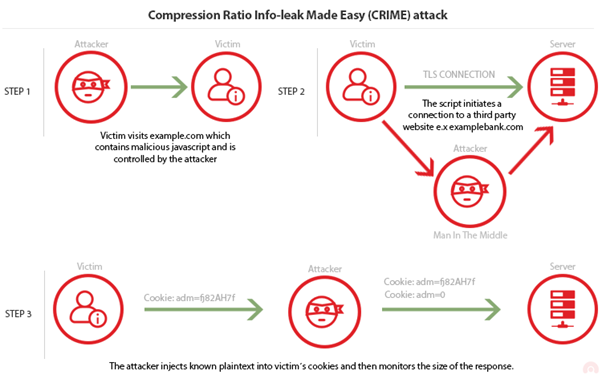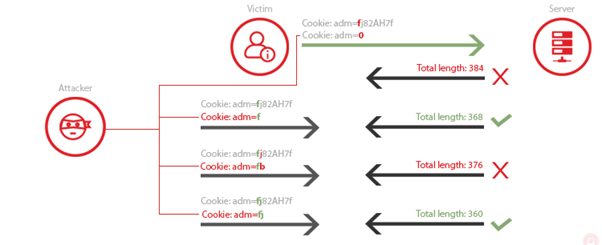Padding Oracle On Downgraded Legacy Encryption (POODLE)
Related CVE: CVE-2014-3566
Target: SSLv3, CBC
- some servers/clients still support SSL 3.0 for interoperability and compatibility with legacy systems (casting)
- a vulnerability that exists in SSL v3.0 which is related to Block Padding (attacking)
-
Cast to SSLv3

-
Attack SSLv3
CBC encryption in SSL 3.0 is that its block cipher padding is not deterministic, and not covered by the MAC
block-ciphered struct {
opaque content[SSLCompressed.length];
opaque MAC[CipherSpec.hash_size];
uint8 padding[GenericBlockCipher.padding_length];
uint8 padding_length;
} GenericBlockCipher;
MAC generation:
hash(MAC_write_secret + pad_2 +
hash(MAC_write_secret + pad_1 + seq_num +
SSLCompressed.type + SSLCompressed.length + SSLCompressed.fragment));
pad_1: The character 0x36 repeated 48 times for MD5 or 40 times for SHA.
pad_2: The character 0x5c repeated 48 times for MD5 or 40 times for SHA.
seq_num: The sequence number for this message.
hash: Hashing algorithm derived from the cipher suite.
Padding Oracle
Target: CBC
Browser Exploit Against SSL/TLS attack (BEAST)
Related CVE: CVE-2011-3389
Target: SSLv3/TLSv1, CBC
An attacker can “decrypt” data exchanged between two parties by taking advantage of a vulnerability in the implementation of the Cipher Block Chaining (CBC) mode in TLS 1.0 which allows them to perform chosen plaintext attack.
Compression Ratio Info-leak Made Easy (CRIME)
Related CVE: CVE-2012-4929
Target: TLS Compression



Browser Reconnaissance and Exfiltration via Adaptive Compression of Hypertext (BREACH)
Related CVE: CVE-2013-3587
Target: HTTP Compression in TLS Communication
Same as above
HeartBleed
Related CVE: CVE-2014-0160


#define n2s(c,s)((s=(((unsigned int)(c[0]))<< 8)| \
(((unsigned int)(c[1])) )),c+=2)
#define s2n(s,c) ((c[0]=(unsigned char)(((s)>> 8)&0xff), \
c[1]=(unsigned char)(((s) )&0xff)),c+=2)
int dtls1_process_heartbeat(SSL *s) {
unsigned char *p = &s->s3->rrec.data[0], *pl;
unsigned short hbtype;
unsigned int payload;
unsigned int padding = 16; /* Use minimum padding */
/* Read type and payload length first */
hbtype = *p++;
n2s(p, payload);
pl = p;
//do something with the payload
if (s->msg_callback)
s->msg_callback(0, s->version, TLS1_RT_HEARTBEAT,
&s->s3->rrec.data[0], s->s3->rrec.length,
s, s->msg_callback_arg);
if (hbtype == TLS1_HB_REQUEST) {
unsigned char *buffer, *bp;
int r;
/* Allocate memory for the response, size is 1 byte
* message type, plus 2 bytes payload length, plus
* payload, plus padding
*/
buffer = OPENSSL_malloc(1 + 2 + payload + padding);
//allocate all that memory without any checks
bp = buffer;
/* Enter response type, length and copy payload */
*bp++ = TLS1_HB_RESPONSE;
s2n(payload, bp);
memcpy(bp, pl, payload);
bp += payload;
/* Random padding */
RAND_pseudo_bytes(bp, padding);
r = dtls1_write_bytes(s, TLS1_RT_HEARTBEAT, buffer, 3 + payload + padding);
//send the response back, even the stuff the attacker wasn't supposed to see
if (r >= 0 && s->msg_callback)
s->msg_callback(1, s->version, TLS1_RT_HEARTBEAT,
buffer, 3 + payload + padding,
s, s->msg_callback_arg);
OPENSSL_free(buffer);
if (r tlsext_hb_seq) {
dtls1_stop_timer(s);
s->tlsext_hb_seq++;
s->tlsext_hb_pending = 0;
}
}
return 0;
}
Conclusion
- Some logical vulnerabilities in operating mode of block cipher (padding oracle)
- Partically verifing data structure (SSLv3 GenericBlockCipher)
- Misconfigure in client and server (POODLE)
- Vulnerbilities in SSL/TLS implement (Heartbleed)